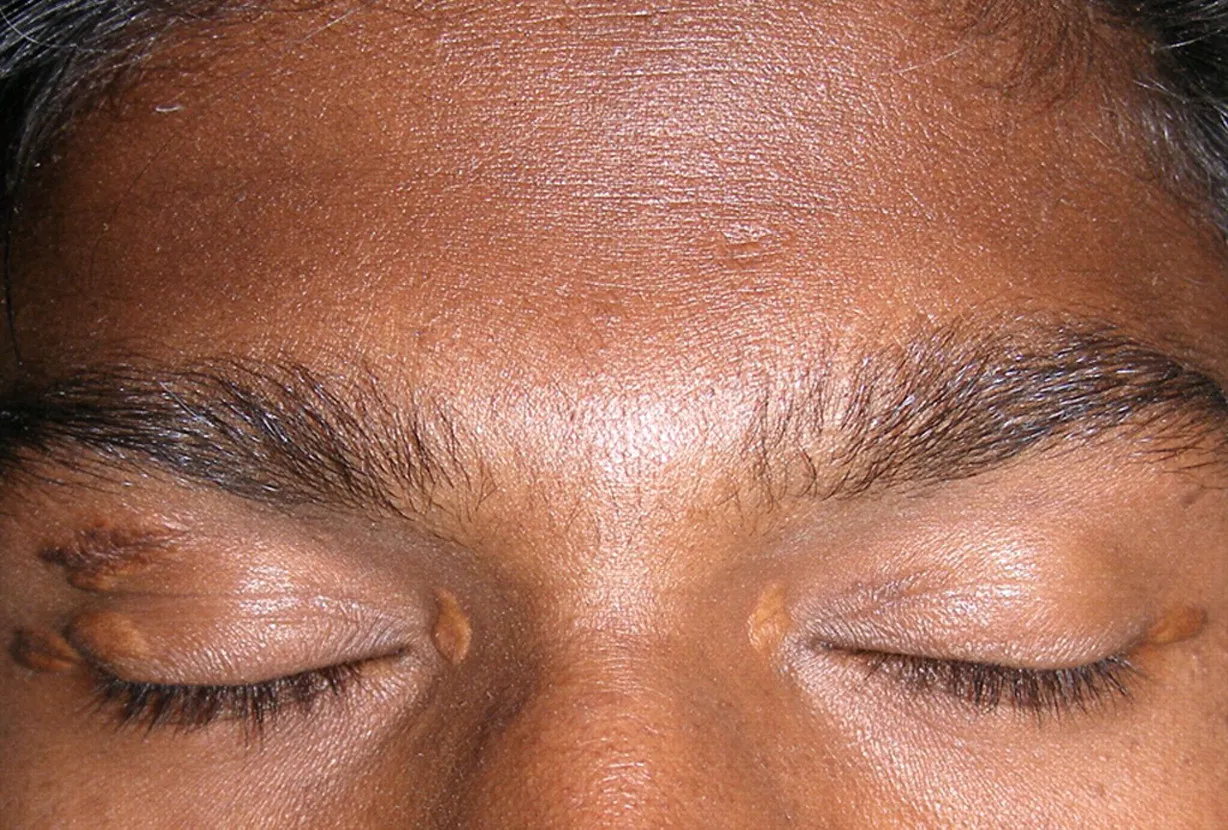What is xanthelasma?
Xanthelasma is a soft, yellowish cholesterol-rich material deposited under the skin in various parts of the body. These deposited lesions are fat-rich or lipids, accumulated in the immune cells in the skin called macrophages and sometime in the fat beneath the skin.
These cutaneous manifestations of lipidosis, lipid accumulated in clusters within the skin, are associated with hyperlipidemias, both primary and secondary types.
Xanthelasma occurs most often on the upper eyelid near the inner canthus and lower lid. Xanthelasma is usually harmless. It may be an early sign of underlying disease hyperlipidemias and ischemic heart disease.
A Xanthoma is a larger and nodular lesion that assumes tumorous proportions; different from xanthelasma and often classified as a subtype of xanthelasma.
Types of xanthelasma: often classified as:
- Xanthelasma Palpebrum: ait is common xanthelasma that develops around the eyes with a demarcated soft yellowish discoloration.
- Xanthoma Planum or Plane xanthoma: : appear as diffuse, flat, smear like lesion, and can occur anywhere on the body.
- Palmar Xanthoma appears as orange-yellow lesions on the palmar creases and flexural surfaces of the fingers. These are flat macules or slightly elevated plaques, often with a central white zone that may be localised or generalise. It occurs with hyperlipoproteinemia type Il A and type lII and biliary cirrhosis. It is also associated with hypercholesterolemia.
- Xanthoma Tuberosum or Tuberous Xanthoma: characterized by firm, yellow-red nodules over pressure areas or over the joints, commonly the elbows and knees
- Xanthoma Tendinosum or Tendinous Xanthoma: typically presentation by papules and nodules over the tendons of the hands, feet, or heels. It is commonly associated with familial hypercholesterolemia.
- Eruptive Xanthoma appears as multiple small, yellowish-orange to reddish-brown papules over the extensor surfaces of the body. It is commonly associated with high levels of triglycerides. Xanthoma diabeticorum is associated with severe diabetes.
- Tubero-eruptive Xanthoma is characterized by red papules and nodules that tend to coalesce. It is considered to be the same disease spectrum of eruptive xanthomata.
- Xanthoma Disseminatum: : is a rare non-familial or non-X histiocytosis, characterized by the proliferation of histiocytic cells and the lipid deposition is secondary. It is associated with diabetes insipidus. The lesions appear as reddish, yellowish-brown papules predominantly involving the flexures (armpits and groins) and evenly spread on both sides of the face, trunk, and upper part of extremities. The small lesions coalesce to form sheets of thickened skin.
- Verrucous Xanthoma or Histiocytosis is associated with papilloma of the oral mucosa and skin, and the connective tissue under the epithelium contains histiocytes.
- Diffuse Plane Xanthomatosis Here multiple flat reddish-yellow xanthomatous macules and plaques develop over the face, neck, chest, buttocks, and skin folds. The lipid levels are normal and in almost half, the conditions have a malignancy of the blood such as leukemia or multiple myeloma.
Risk factors?
The following factors and conditions to be considered are:
- Abnormal high lipid profile
- Obesity
- Smoker
- Middle age between 30 to 55 yrs
- Woman
- High blood pressure
- Diabetes
Anyone can develop xanthelasma, but the above-mentioned condition or factors are more prone to get.
Treatment
Xanthelasma does not resolve on its own; it needs an expert opinion and guidance. It is harmless and it can only spread if not treated.
Conservative measures such as an individual’s lifestyle, diet, and medication to reduce cholesterol play a major role.
- Avoid smoking and cut of alcohol.
- Reduce calorie intake in overweight individuals to lose weight
- Regular walking and exercise
- Reduce saturated fat intake, predominately found in butter, dairy products, palm oil, and meat.
- Reduce intake of normal and refined sugars, soft drinks.
- Consume more of fiber-rich vegetables, salads, etc.,
Medication: has proved to be a very effective alternative to surgery. It can be administered in combination to have effective results. Drugs such as atorvastatin or simvastatin or bezafibrate are most commonly used and work by reducing cholesterol production by the liver, which in turn reduces LDL cholesterol, triglycerides level, and increase in HDL cholesterol. These drugs are to be taken under medical supervision.
Other drugs such as ezetimibe, nicotinic acid are also used to reduce total and LDL cholesterol.
Interventional Treatment: is required, if the conservative medication does not work for your xanthelasma; any one of the following treatment can be done:
Chemical peels: with trichloroacetic acid (TCA) shown satisfactory to excellent results, but multiple sessions are required with an interval of 7 to 10days.
Cryotherapy: This involves freezing the xanthelasma with liquid nitrogen.
Radiofrequency device: an advanced radiofrequency device by Ellman technique is effective at eliminating or reducing xanthelasma.
Laser surgery: ablative laser such CO2 and Erbium Yag either in conventional or fractional mode is effective in eliminating xanthelasma.
It is possible xanthelasma may reappear after treatment. However, it is extremely important to find out the cause and treat accordingly

